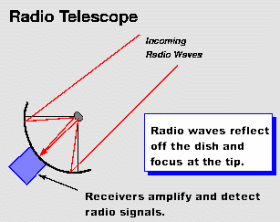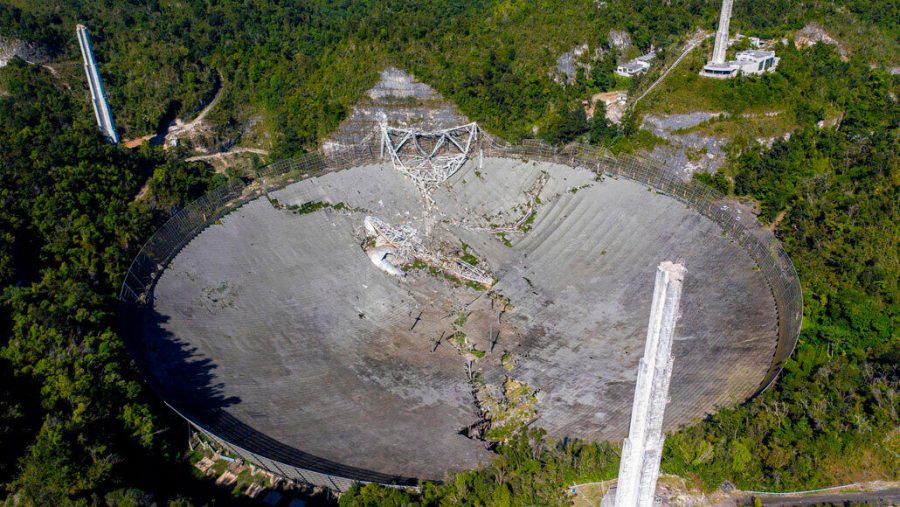Arecibo Telescope: A Retrospective
In the wake of its collapse, scientists around the world are mourning the loss of the Arecibo telescope. But what made it so important in the first place, and how will its absence affect the world of astronomy moving forward?
In the early hours of December 1st, 2020, the cables that suspended the massive Arecibo radio telescope snapped, and the 900 ton instrument came crashing down to the ground. This event had impacts that rippled throughout the scientific community, but to understand these impacts, we first need to understand what the Arecibo Telescope was.
A Brief History
The Arecibo Telescope was constructed near the city of Arecibo, Puerto Rico. It was built in 1963 by the United States Air Force as a means of studying Earth’s atmosphere. Later, it was discovered that the telescope could be extremely useful for the field of radar astronomy. The telescope consisted of a platform suspended by 18 cables over  a gigantic dish that covers an area of nearly 20 acres, and before its collapse, it was the world’s second largest radio telescope with a single dish. It held the record for the largest for decades until it was surpassed by another telescope called FAST, which is located in China. So you might be wondering: how does the radio telescope work?
a gigantic dish that covers an area of nearly 20 acres, and before its collapse, it was the world’s second largest radio telescope with a single dish. It held the record for the largest for decades until it was surpassed by another telescope called FAST, which is located in China. So you might be wondering: how does the radio telescope work?
First, radio waves are received from the object that the telescope is observing.The radio waves then hit the dish of the telescope and bounce off of it. They bounce into the tip, where the waves focus, and the waves finally reach the receiver. The receiver detects the radio waves and amplifies them, and with this, we can create images. Amplifiers are extremely important for detecting a signal, due to the fact that the signals we receive on Earth can be extremely faint. One downside to radio telescopes is that they can pick up radio waves off of the ground instead of the object that the telescope is observing.
In the years after it was built, the telescope has been upgraded many times. Some of these upgrades included increasing the range of frequencies the telescope can pick up, and making it so that the telescope doesn’t pick up radio waves from the ground. In August of 2020, the first cable that supported the platform of the telescope snapped. After it snapped, it made a large cut in the dish of the telescope. While this was extremely concerning, it was still repairable. However, in November of 2020, another cable broke. The National Science Foundation deemed it too dangerous to repair, and the telescope’s fate was sealed. In December of 2020, it collapsed completely in a horrible turn of events.
Notable Discoveries
The Arecibo Telescope has made a plethora of discoveries in its lifetime. One of its most impressive discoveries was observing the first ever exoplanet orbiting a star. An exoplanet is a planet that exists outside of our solar system. This observation paved the way for thousands of exoplanets to be discovered later, and it started the journey to finding a habitable planet outside of the solar system.
Another responsibility that the telescope had was to create images of near-Earth asteroids. This would help scientists to better understand which asteroids could pose a threat to Earth. This is super important to preventing possible collisions with Earth from outside objects. Arecibo was also used to map the surface of Venus. Venus had always been a tricky planet to figure out for astronomers, due to the thick layer of gas surrounding it making it nearly impossible to observe it. However, with the power of the Arecibo Telescope, we were able to map the surface of Venus extremely accurately. Those are just a few of the findings that have come out of Arecibo Telescope, and there are many more that have been extremely useful to the field of astronomy.
The Implications Of Its Collapse
With all of its accomplishments, it is easy to see how the collapse of the Arecibo Telescope is a massive blow to astronomers worldwide. The enormous size of the telescope’s dish makes it almost irreplaceable. Additionally, a recent statement by the National Science Foundation has stated that cleaning up the wreckage of the telescope could cost 50 million dollars. No other telescope in the world is as well equipped to detect near-Earth asteroids as Arecibo Telescope was. This is because Arecibo had transmitters as well as receivers. Transmitters allowed the telescope to transmit radio waves at an object it is observing, to produce clear images. Arecibo was the site of many current research projects as well, and those were all lost in its collapse.
The loss of the Arecibo Telescope was a huge setback for the scientific community, and its capabilities and discoveries will be remembered for years to come. While it is gone, that doesn’t mean that the data that has come out of it has been completely exhausted. There have been many cases where looking back at old telescope data has revealed something new. For example, old telescope data from the Hubble Space Telescope has suggested that the ingredients to support life might exist on Europa, one of Jupiter’s moons. With the sheer amount of data the telescope has collected, it will surely continue to be a great asset to scientific research. While it may be gone, the Arecibo Telescope has left a beautiful legacy that will continue to build as time goes on.



Anonymous • Mar 28, 2021 at 12:59 pm
This is the best article I have ever laid my eyes on, amazing!